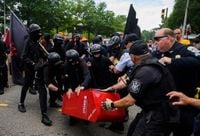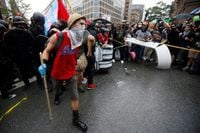On October 8, 2025, the ornate State Dining Room of the White House became the stage for a highly charged roundtable, as President Donald Trump gathered cabinet officials, law enforcement leaders, and a cadre of conservative influencers to spotlight what the administration brands as the growing menace of Antifa. The event, which spanned nearly two hours and played out before television cameras, was intended to send a resounding message: the Trump administration is intensifying its campaign to label the anti-fascist movement as a grave threat to national security—and it’s prepared to use every tool at its disposal to dismantle it.
President Trump opened the discussion by declaring, “The epidemic of left-wing violence and Antifa inspired terror has been escalating for nearly a decade.” According to TNND, Trump and his team repeatedly described Antifa as a “left-wing terror threat,” emphasizing their resolve to crack down on what they portrayed as a shadowy network bent on undermining American democracy. The President’s rhetoric was forceful, hinting not just at domestic action but at international measures as well. “If you agree, I agree. Let’s get it done,” Trump said, instructing his cabinet to move toward declaring Antifa a foreign terrorist organization—a move reported by Reuters that would be unprecedented for a group that is, by all accounts, a domestic and decentralized movement.
Attorney General Pam Bondi, echoing the President’s hardline stance, reminded the gathering of Trump’s September executive order designating Antifa as a domestic terrorist organization. “We can’t and we will not let masked terrorists burn our buildings, attack our law enforcement and intimidate our communities,” Bondi insisted. She likened the administration’s strategy to the fight against drug cartels: “We’re going to take the same approach, President Trump, with Antifa, destroy the entire organization, from top to bottom. We’re going to take them apart.”
Homeland Security Secretary Kristi Noem took the rhetoric a step further, drawing direct comparisons between Antifa and notorious criminal and terrorist organizations. “This network of Antifa is just as sophisticated as MS-13, as TDA [Tren de Aragua], as ISIS, as Hezbollah, as Hamas, as all of them,” Noem declared, as reported by CBC. “They are just as dangerous. They have an agenda to destroy us, just like the other terrorists we’ve dealt with for many, many years.” Noem’s comments, however, came without any presentation of intelligence indicating that Antifa possesses the weaponry or organizational structure of these groups—a point that has drawn skepticism from legal experts and civil liberties advocates alike.
FBI Director Kash Patel also spoke forcefully, vowing to “follow the money” to dismantle Antifa’s alleged networks. “That’s what it’s going to take to bring down this network of organized criminal thugs, gangbangers, and yes, domestic terrorists because that’s what they are,” Patel said. He pledged that the FBI “will not rest until we find every single seed money, donor organization and funding mechanism that we have,” and noted ongoing collaboration with Treasury Secretary Scott Bessent to map out Antifa’s alleged financial infrastructure. Patel also offered praise for the independent journalists and commentators present, saying, “They’re putting their lives on the line, they’re standing up for the flag, the least we can do is stand up for them, so you have my thanks. I read more of your stories than I do theirs.”
Throughout the event, the administration gave the floor to several conservative social media personalities, many of whom recounted stories of violence at the hands of Antifa-affiliated protestors. Nick Sortor, who was recently arrested in Portland, Oregon, after an altercation with demonstrators, claimed, “The Portland politicians are literally willing to sacrifice their own citizens just to appease these antifa terrorists. It’s sickening. I’ve seen it firsthand.” Sortor, who has threatened to sue the Portland Police Department for what he claims was an attempt to silence conservative media, demanded an apology from city authorities. Andy Ngo, another prominent conservative journalist, recalled a 2019 assault in Portland: “The punches came from everywhere. On my head, in my face, and I was bleeding out (of) my eyes and ears.”
Jack Posobiec, a commentator with a large social media following, urged the President to take decisive action: “Mr. President, we need to do something about this because I fear that the next one who could be killed could be sitting at this table right now.” These personal accounts were used by the administration to underscore what it describes as a campaign of violence by Antifa and its supporters, particularly against law enforcement and federal agents. “You should see what we have on these people. These are bad people. These are people that want to destroy our country,” Trump asserted during the roundtable.
Yet, as CBC and Reuters both noted, the administration’s case faces significant legal and practical hurdles. Antifa, short for anti-fascist, is not a formal organization but rather a loosely affiliated, leaderless movement. Legal analysts point out that the U.S. government has never before designated a domestic group as a terrorist organization, and there is no law that allows the same kind of prosecution for domestic groups as there is for foreign terrorist entities. David Schanzer, a counterterrorism expert and professor at Duke University, voiced skepticism about the administration’s claims. “They’re trying to demonstrate that there’s some sort of threat out there to the average American,” Schanzer said. “If there’s a clear and present threat, if they have evidence of this level of organization, then they have an obligation to protect the American public and wrap these organizations up.”
The event also featured a sharp critique of the media. Trump and several participants accused mainstream outlets of downplaying violence by Antifa and failing to give voice to conservative victims. “What network would you say is the worst?” Trump quipped, taking aim at CNN and MSNBC. Sortor dismissed the press pool as “garbage,” while fellow activist Nick Shirley lamented that legacy media had ignored his perspective.
Despite the administration’s strong rhetoric, the practical implications of these moves remain unclear. As CNN reported, Trump acknowledged the amorphous nature of Antifa, calling it “more of an ideology than an organized group.” Still, he left little doubt about his intentions: “We’re going to be very threatening to them, far more threatening to them than they ever were with us. And that includes the people that fund them, probably some of the people I know, some of the people I dine with. But if they do, they’re in deep trouble, so we’re going to be looking very strongly at the people that are funding these operations.”
As the event closed, Trump offered one last jab at the press before departing for a Middle East peace meeting: “Although you have some very honest journalists in here, you also have some mostly largely dishonest journalists, like MS-DNC and CNN—I think they’re very dishonest, unbelievably, like a waste of time even talking to them.”
The White House’s latest roundtable on Antifa underscores the administration’s determination to frame the movement as an existential threat, even as legal and practical constraints complicate efforts to translate rhetoric into action. For now, the debate over the true nature, scope, and danger of Antifa—and the government’s response—shows no signs of cooling off.


